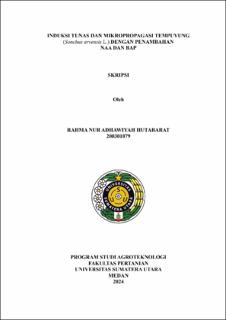Induksi Tunas dan Mikropropagasi Tempuyung (Sonchus arvensis L.) dengan Penambahan NAA dan BAP
Shoot Induction and Micropropagation of Tempuyung (Sonchus arvensis L.) with the Addition of NAA and BAP

Date
2024Author
Hutabarat, Rahma Nur Adhawiyah
Advisor(s)
Siregar, Luthfi Aziz Mahmud
Metadata
Show full item recordAbstract
Tempuyung (Sonchus arvensis L.) is a traditional medicinal pf ant that lives wild and has not been widely cultivated. Constraints in tempuyung cultivation can result in the loss of germplasm sources caused by direct collection from the environment. Therefore, the role of biotechnology was needed to overcome this problem through tissue culture. This study aims to determine the shoot induction and micropropagation of tempuyung with the addition of growth regulators Naphthaleneacetic Acid (NAA) and Benzyl Amino Purine (BAP) in vitro. The research was conducted at the Plant Tissue Culture Laboratory, Faculty of Agriculture, University of North Sumatra, from January to April 2024. The experimental design used in this study was a completely randomised design with 2 treatment factors. The first factor was the concentration of NAA which consists of 3 levels and the second factor was the concentration of BAP which consists of 4 levels and 12 treatment combinations with 4 replications. NAAfactor (0.0; 0.5; 1.0 mg/[). BAP factor (0.0; 2.0; 4.0; 6.0 mgll). The parameters observed in this study include the percentage of exp/ants forming buds, the percentage of exp/ants forming callus buds, the age of bud emergence, the number of buds and the length of buds. The results showed that the provision of NAA and BAP had a significant effect on the number of shoots and shoot length. The combination of 1 mg/I NAA + 6 mg/I BAP was the best combination in inducing shoots with the number of shoots 7 shoots and shoot length 2.73 cm.
Collections
- Undergraduate Theses [3566]
